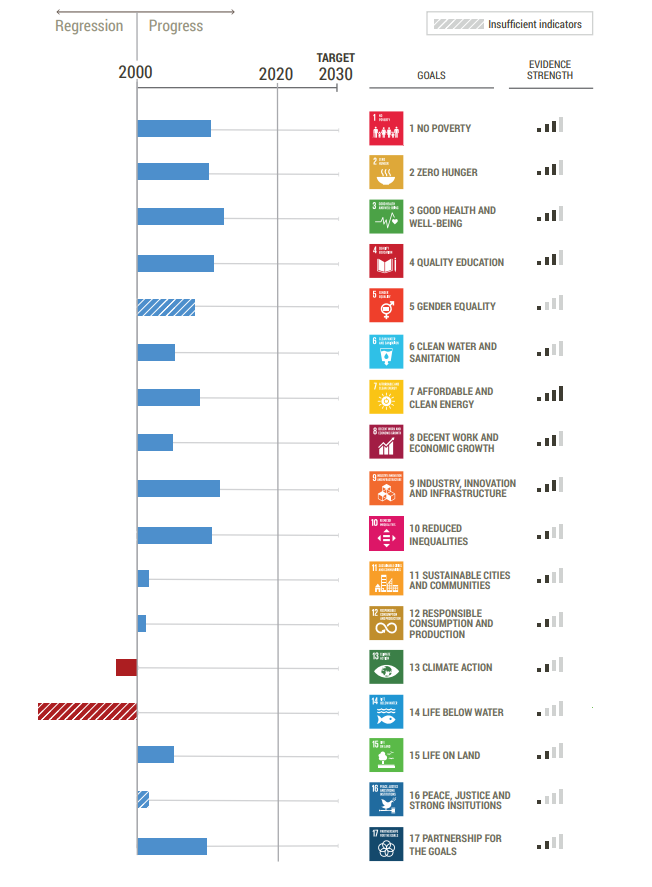1. A universal framework for sustainable development
In 2015, after two years of negotiations within the international community, the UNGA resolution “Transforming Our World: the 2030 Agenda for Sustainable Development” (United Nations, 2015b), including its 17 Goals and 169 targets, was adopted by Heads of State and Governments in New York (figure 1). The 2030 Agenda is a commitment to eradicating poverty and achieving sustainable development world-wide by 2030, and ensuring that no one is left behind. Its adoption was a landmark achievement, providing for a shared global vision towards sustainable development for all. The 2030 Agenda takes into account other approved agendas, such as the Sendai Framework for Disaster Risk Reduction (United Nations International Strategy for Disaster Reduction, 2015) and the Addis Ababa Action Agenda (United Nations, 2015a), acknowledging their contribution without duplicating objectives and targets.
Did you know...?
Reporting against the SDGs is structured around a three-tiered follow-up and review architecture at the national, regional and global levels. The 2030 Agenda encourages United Nations member States to “conduct regular and inclusive reviews of progress at the national and subnational levels, which are country-led and country-driven” (United Nations, 2015b). The voluntary national reviews (VNRs) are the primary method for countries to document and share their efforts in implementing the SDGs. Through the VNR process, countries have a chance to revise national development goals and targets, assess and strengthen the adequacy of national policies and institutions, and mobilize multi-stakeholder support through the creation of partnerships for the achievement of the SDGs. At the regional level, the follow-up and review process takes the form of Regional SDG Forums, such as the Asia-Pacific Forum on Sustainable Development, which emphasize peer learning and exchange of good practices in the regional context. The HLPF has the central role in overseeing the network of follow-up and review processes at the global level. Upon completion of their VNR, countries have the opportunity to present their report at the HLPF, thereby sharing their experiences, including successes, challenges and lessons learnt, with their peers.
Since 2015, countries have taken action to integrate the SDGs and targets of the 2030 Agenda into their national development plans, and to align policies and institutions behind them. While advances have been made, monumental challenges remain in the Asia-Pacific region, particularly in the environment-related SDGs (figure 2). In September 2019, the United Nations Secretary-General called on all sectors of society to mobilize for a Decade of Action on three levels – global action to secure greater leadership, more resources and smarter solutions for the Sustainable Development Goals; local action embedding the needed transitions in the policies, budgets, institutions and regulatory frameworks of governments, cities and local authorities; and people action, including by youth, civil society, the media, the private sector, unions, academia and other stakeholders – to generate an unstoppable movement pushing for the required transformations (United Nations, 2019).
The Decade of Action’s recognition of cities and local authorities as critical actors in accelerating the implementation of the SDGs is not the first time the importance of the urban context has been highlighted in policy debates (figure 3). The 2030 Agenda has a cities’ goal, SDG 11, which calls for “inclusive, safe, resilient, and sustainable” cities. It focuses not only on cities, but takes a place-based approach with emphasis on urban, rural-urban and regional linkages. In late 2016, the United Nations adopted a specific agenda for cities, the New Urban Agenda, which calls for compact cities, polycentric growth, transit-oriented development, adequate public space and reining in sprawl (United Nations, 2016). The New Urban Agenda was adopted as a collective vision and political commitment to promote and realize sustainable urban development, and as an opportunity to leverage the key role of cities and human settlements as drivers of development in an increasingly urbanized world (United Nations Economic and Social Commission for Asia and the Pacific and UN-Habitat, 2019).
While the SDGs have a substantial but implicit urban dimension, the New Urban Agenda adds value by formulating a clear aspirational vision, which can mobilize relevant urban stakeholders and guide local implementation. In fact, up to 65 percent of the SDG targets may not even be fully achieved without the involvement of urban and local actors (Cities Alliance, 2015).
To allow the co-creation of new frameworks of governance that is meaningful and practical in the day-to-day lives of citizens, it is necessary to root the implementation of the 2030 Agenda in local and regional priorities. The next section briefly discusses the topic of SDG localization and its status in the Asia-Pacific region.
Did you know...?
SDG 11 has been evaluated to be directly linked to the targets and indicators of at least 11 other SDGs. Furthermore, almost one-third of the 232 SDG indicators can be measured at the local level, making SDG 11 an important unit for action and tracking progress towards sustainable development (UN-Habitat, 2018)


